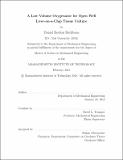| dc.contributor.advisor | David L. Trumper. | en_US |
| dc.contributor.author | Rathbone, Daniel Rodion | en_US |
| dc.contributor.other | Massachusetts Institute of Technology. Department of Mechanical Engineering. | en_US |
| dc.date.accessioned | 2019-02-05T15:17:34Z | |
| dc.date.available | 2019-02-05T15:17:34Z | |
| dc.date.copyright | 2018 | en_US |
| dc.date.issued | 2018 | en_US |
| dc.identifier.uri | http://hdl.handle.net/1721.1/120193 | |
| dc.description | Thesis: S.M., Massachusetts Institute of Technology, Department of Mechanical Engineering, 2018. | en_US |
| dc.description | This electronic version was submitted by the student author. The certified thesis is available in the Institute Archives and Special Collections. | en_US |
| dc.description | Cataloged from student-submitted PDF version of thesis. | en_US |
| dc.description | Includes bibliographical references (pages 139-142). | en_US |
| dc.description.abstract | MicroPhysiological Systems (MPS) show significant promise in speeding drug development and advancing basic research. They may serve better than animal models for obtaining accurate human response data and thereby reducing failed clinical trials. The CN Bio LiverChip is one such commercial MPS device which cultures liver cells on a perforated polystyrene scaffold and actively circulates cell culture medium through them. Reducing the total circulating volume is desirable to increase the concentration of difficult-to-detect compounds, improve autocrine signaling, and achieve more physiologically relevant drug decay times. However, achieving adequate oxygenation at lower volumes is challenging due to surface tension effects. This thesis describes an open-well, flow-through MPS platform with a low-volume oxygenator, at a total circulating volume of approximately 500 [mu]L. The oxygenator uses the interior corner of a hydrophilic spiral to constrain the circulating fluid and to create a thin fluid region, which decreases the diffusion depth relative to exposed surface area, thereby improving oxygenation. The oxygenator performs equivalently to the LiverChip at a fraction of the volume, and features a downward slope that prevents fluid from accumulating in the oxygenator, which could deplete the cell culture well. The fluidic configuration and other design considerations are described, as well as hardware testing results and improved methods for preventing fluid from bypassing the scaffold. This project was supported by NIH grant number UH3-TR000496. | en_US |
| dc.description.statementofresponsibility | by Daniel Rodion Rathbone. | en_US |
| dc.format.extent | 150 pages | en_US |
| dc.language.iso | eng | en_US |
| dc.publisher | Massachusetts Institute of Technology | en_US |
| dc.rights | MIT theses are protected by copyright. They may be viewed, downloaded, or printed from this source but further reproduction or distribution in any format is prohibited without written permission. | en_US |
| dc.rights.uri | http://dspace.mit.edu/handle/1721.1/7582 | en_US |
| dc.subject | Mechanical Engineering. | en_US |
| dc.title | A low volume oxygenator for open well Liver-on-a-Chip tissue culture | en_US |
| dc.type | Thesis | en_US |
| dc.description.degree | S.M. | en_US |
| dc.contributor.department | Massachusetts Institute of Technology. Department of Mechanical Engineering | |
| dc.identifier.oclc | 1083126115 | en_US |
